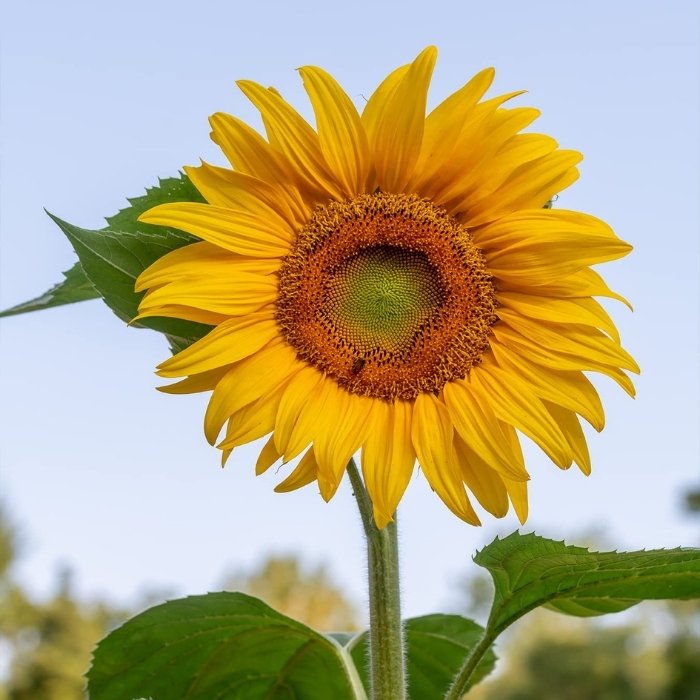A Comprehensive Guide to Growing Mammoth Sunflowers
Mammoth sunflowers, known for their towering height and radiant blooms, are a stunning addition to any garden. These giants of the plant world not only provide breathtaking visual appeal but also yield seeds that are perfect for snacking or bird feed. In this guide, we will delve into the details of growing, caring for, and utilizing these magnificent flowers to ensure you achieve the most impressive results.
What Are Mammoth Sunflowers?
Mammoth sunflowers (Helianthus annuus) are a variety of sunflower that can grow up to 12 feet tall or more. Their enormous flower heads, often exceeding 12 inches in diameter, are filled with hundreds of edible seeds. These sunflowers are annual plants, completing their life cycle within a single growing season, and are highly prized for their ornamental and functional value.
Ideal Growing Conditions for Mammoth Sunflowers
Soil Requirements
To cultivate mammoth sunflowers successfully, it is crucial to provide them with the right soil conditions. They thrive in well-draining, nutrient-rich soil with a slightly acidic to neutral pH (6.0–7.5). Enrich the soil with organic compost or well-rotted manure to ensure adequate nutrients for robust growth.
Sunlight
As the name suggests, sunflowers require abundant sunlight. Choose a location that receives 6–8 hours of direct sunlight daily to promote healthy growth and maximize flower size.
Watering
Although mammoth sunflowers are drought-tolerant once established, consistent watering is essential during their early growth stages. Water deeply but infrequently, ensuring the soil remains moist but not waterlogged.
How to Plant Mammoth Sunflowers
Choosing the Right Seeds
Select high-quality mammoth sunflower seeds from reputable suppliers. Look for seeds labeled “Mammoth Grey Stripe” or “Russian Giant” for the best results.
Planting Time
Mammoth sunflowers should be planted in the spring, after the last frost date. The soil temperature should be at least 50°F (10°C) for optimal germination.
Planting Process
- Prepare the Soil: Loosen the soil to a depth of 2 feet to accommodate the deep roots. Add compost or organic matter to enrich the soil.
- Spacing: Plant seeds 1 inch deep and 18–24 inches apart to give each sunflower ample space to grow.
- Watering: Water the planted area thoroughly and keep it consistently moist until germination occurs, typically within 7–10 days.
Caring for Mammoth Sunflowers
Fertilization
Feed your sunflowers with a balanced fertilizer (10-10-10) every two weeks during their growing season. Avoid over-fertilizing, as this can lead to excessive foliage growth at the expense of flowers.
Staking
Due to their height, mammoth sunflowers can be prone to wind damage. Use sturdy stakes or supports to prevent them from toppling over, especially in windy conditions.
Pest and Disease Management
- Pests: Keep an eye out for aphids, sunflower moths, and birds. Use insecticidal soap or neem oil to manage pests and consider netting to protect seeds from birds.
- Diseases: Prevent fungal diseases such as downy mildew by ensuring proper air circulation around the plants and avoiding overhead watering.
Harvesting Mammoth Sunflowers
When to Harvest
The sunflower seeds are ready for harvest when the back of the flower head turns yellow or brown, and the seeds are firm to the touch.
How to Harvest
- Cut the Flower Head: Use sharp garden shears to cut the flower head, leaving about 12–18 inches of stem attached.
- Dry the Seeds: Hang the flower head upside down in a well-ventilated area to allow the seeds to dry completely.
- Remove the Seeds: Rub the flower head gently to release the seeds.
Creative Uses for Mammoth Sunflowers
Seed Consumption
Mammoth sunflower seeds are rich in nutrients and can be roasted for a healthy snack. Season them with salt or spices for added flavor.
Wildlife Attraction
Leave the mature flower heads in your garden to attract birds such as finches and cardinals, who will feast on the seeds.
Ornamental Displays
Use the towering stems and vibrant blooms as stunning focal points in your garden or as part of decorative arrangements.
Common Challenges and Solutions
Poor Germination
Ensure seeds are planted in warm soil and receive adequate moisture during germination. Avoid planting too early when the soil is still cold.
Yellowing Leaves
Yellow leaves may indicate overwatering or a lack of nitrogen. Adjust your watering schedule and consider using a nitrogen-rich fertilizer.
Small Flower Heads
This is often caused by insufficient sunlight or overcrowding. Ensure your sunflowers are spaced appropriately and receive ample sunlight.
Conclusion
Growing mammoth sunflowers is a rewarding endeavor that brings beauty, functionality, and a touch of grandeur to any garden. By following the guidelines outlined in this article, you can cultivate towering plants that will leave a lasting impression on all who see them. Prime Ark Freedom Blackberry

